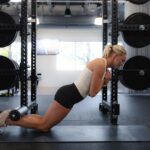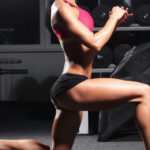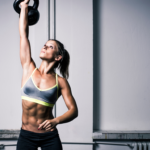Disclosure:
Thank you for reading this post, don't forget to subscribe!
Some of the links on this website are affiliate links. This means that if you click on the link and make a purchase, we may receive a small commission at no extra cost to you. Your support helps us keep the site running.Learn more on my Privacy Policy and Affiliate Disclosure page. Thank you for your support!
The deadlift is one of the most effective compound exercises, renowned for building strength, improving functional fitness, and activating multiple muscle groups. For anyone interested in strength training, weightlifting, or general fitness, the deadlift is a fundamental movement. This guide breaks down everything you need to know about mastering the deadlift, from technique to variations, tips, and common mistakes to avoid.
What is the Deadlift?
The deadlift is a weightlifting exercise that primarily targets the posterior chain, engaging muscles like the glutes, hamstrings, and lower back. It also activates the core, shoulders, traps, and forearms, making it an excellent exercise for overall strength. Unlike other lifts, the deadlift simulates real-life movements, helping improve posture, stability, and daily functional movements.
For more expert tips on improving your fitness routine, check out our Beginner’s Guide to Weight Loss for practical advice on building strength and staying motivated.
Why Deadlifts are Essential for Muscle Growth and Strength
- Compound Movement: The deadlift is a compound exercise, which means it targets multiple muscle groups simultaneously. This not only maximizes efficiency but also triggers greater muscle growth.
- Functional Strength: Deadlifts mimic movements like bending, lifting, and pulling, which are essential in everyday life.
- Metabolic Boost: Since deadlifts engage large muscle groups, they boost metabolic rate, aiding in fat loss and overall body composition.
Types of Deadlifts
1. Conventional Deadlift
The conventional deadlift is the standard version, often the starting point for beginners. In this variation:
- Feet are hip-width apart.
- Hands grip the bar just outside the knees.
- The lift emphasizes the hamstrings, glutes, and lower back.
2. Sumo Deadlift
In the sumo deadlift, you take a wide stance with toes slightly angled out and hands positioned inside your knees.
- The wider stance reduces strain on the lower back and shifts focus to the hips, quads, and glutes.
- Ideal for those with limited hip mobility or longer legs.
3. Romanian Deadlift (RDL)
The Romanian deadlift focuses on the hamstrings and glutes.
- This variation starts from a standing position, lowering the bar with a slight knee bend.
- By limiting the range of motion, RDLs minimize lower back involvement and emphasize the posterior chain.
4. Trap Bar Deadlift
Using a trap (or hex) bar allows a neutral grip, often seen as more joint-friendly.
- This position reduces strain on the lower back, making it ideal for beginners or those with back pain.
- The lift combines elements of the squat and deadlift, targeting the quads, hamstrings, and glutes.
Discover the science behind strength training at mayo clinic to learn more about the benefits of exercises like the deadlift.
read next:
The Anti-Burnout Fitness Plan: Building Sustainable Exercise Habits That Last A Lifetime
Burnout isn’t just about feeling worn out after a long day. It’s…
Top Shoulder Workouts For Muscle Definition
Are you looking to achieve defined, sculpted shoulders but unsure which exercises…
Mastering the Deadlift Technique: Step-by-Step Guide
1. Set Up
- Position the Barbell: Stand with the barbell directly over your mid-foot.
- Foot Position: Feet should be hip-width apart, and toes pointed slightly outward.
2. Grip and Brace
- Grip: Grab the barbell just outside your knees, using either a double overhand or mixed grip.
- Brace the Core: Engage your core by taking a deep breath and “locking” your abdomen.
- Back Position: Keep your back neutral with shoulders over the bar, avoiding any rounding or excessive arching.
3. Initiate the Lift
- Drive with the Legs: Push through your heels, extending your knees and hips simultaneously.
- Maintain Arm Position: Keep your arms straight without pulling with your biceps.
- Keep the Bar Close: Slide the bar along your shins as you lift, maintaining control and avoiding any jerking motion.
4. Lockout
- At the top, stand tall with a slight squeeze of the glutes.
- Avoid excessive leaning back, which can put strain on the lower back.
5. Lower the Bar
- Controlled Descent: Lower the bar by hinging at the hips and slightly bending the knees.
- Positioning: Ensure the bar travels back down close to your body, keeping your form intact.
For more advanced deadlift techniques and variations, visit Bodybuilding.com’s Deadlift Resource to explore different ways to enhance your training.
Common Deadlift Mistakes and How to Avoid Them
Mistake #1: Rounding the Back
Solution: Maintain a neutral spine by bracing your core and retracting your shoulder blades. This avoids unnecessary strain on the lower back.
Mistake #2: Lifting with the Arms
Solution: Remember, the deadlift is a lower-body lift. Engage the legs and hips first, keeping the arms straight.
Mistake #3: Jerking the Bar Off the Ground
Solution: Instead of yanking the bar, initiate the lift with controlled force, driving through the heels.
Mistake #4: Overextending at Lockout
Solution: Stand tall without leaning back excessively. Squeeze the glutes lightly to avoid hyperextension.
Tips for Improving Deadlift Strength
1. Focus on Progressive Overload
Progressive overload involves gradually increasing weight, reps, or intensity. Aim to add small increments each session, prioritizing form over heavy weights.
2. Incorporate Accessory Exercises
Adding accessory exercises like hip thrusts, good mornings, and glute bridges strengthens muscles used in the deadlift.
3. Program with Purpose
Design your deadlift program around your specific goals. For strength, stick to lower reps (3-5) with heavier weights. For muscle endurance, try moderate weight with higher reps (8-12).
4. Rest and Recovery
The deadlift is taxing on the body. Prioritize recovery by incorporating rest days, adequate sleep, and stretching routines.
explore more:
Deadlift Safety and Injury Prevention
1. Warm-Up Properly
Starting with a warm-up reduces the risk of injuries. Include dynamic stretches and mobility exercises for hips, hamstrings, and glutes.
2. Use Proper Equipment
Consider wearing a lifting belt to protect your lower back during heavier lifts. Proper footwear, like flat-soled shoes, helps with balance and ground contact.
3. Listen to Your Body
If you feel discomfort or strain, assess your form or lighten the load. It’s essential to recognize when your body needs rest to avoid overuse injuries.
4. Seek Professional Guidance
For beginners or those lifting heavy, working with a certified trainer can help you master form, preventing injury and ensuring you get the most out of the lift.
Conclusion
Mastering the deadlift requires a combination of good form, gradual progression, and an understanding of different variations. Whether you’re a beginner or intermediate lifter, the deadlift can transform your fitness, building strength, stability, and confidence in your lifting journey. Remember, consistency and attention to form are key.
For more fitness tips and to download our free deadlift workout plan, subscribe to our newsletter.
more about:
HEALTH / WELLNESS / FITNESS / NUTRITION
share this article













